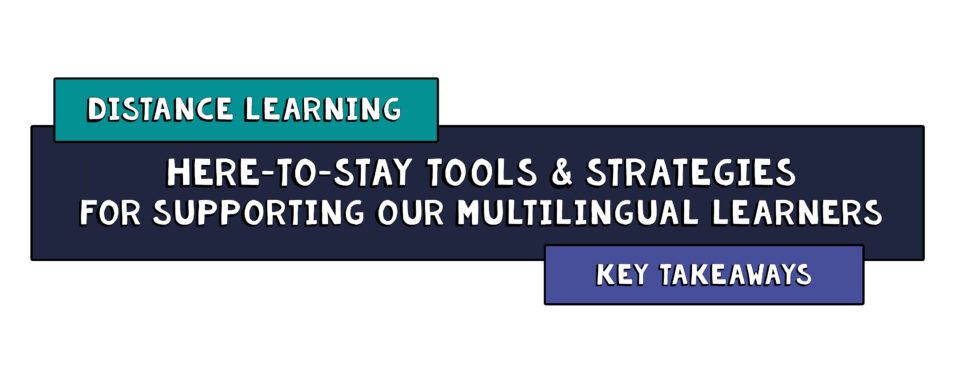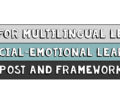
I vividly remember the day in March of 2020 when my school system in Maryland announced that we would temporarily be shutting down. At the time I was working at the district level in an English language development curriculum office. When we shut down and it was announced that instruction would continue virtually, my team’s immediate thought was “How is this going to work? Our curriculum is developed for face-to-face instruction with student interaction at the heart. How are we going to adapt it to a virtual model?” We worked for hours on end in virtual meetings planning how we could make learning work for our multilingual learners (MLs), teachers, and families. We were proud of what we created. Little did we know how quickly things would evolve!
 Over the course of the 2020 – 2021 school year teachers demonstrated their incredible creativity and innovation when faced with the challenges of distance, hybrid, and concurrent learning. Teachers’ instruction developed from simple asynchronous slide shows to interactive, engaging, and (even) fun virtual and hybrid instruction! It was not easy; teachers worked unbelievably hard to make this happen.
Over the course of the 2020 – 2021 school year teachers demonstrated their incredible creativity and innovation when faced with the challenges of distance, hybrid, and concurrent learning. Teachers’ instruction developed from simple asynchronous slide shows to interactive, engaging, and (even) fun virtual and hybrid instruction! It was not easy; teachers worked unbelievably hard to make this happen.
I believe some tools and strategies that emerged from virtual learning have the potential to positively impact education for multilingual learners and are here to stay. In this blog post, I share three tools and strategies for multilingual learners from distance learning that I feel should continue as school systems transition back to in-person instruction this school year.
In March 2021 I began working as an EL Coach for SupportEd, and we asked teachers on Twitter about tools and strategies for multilingual learners from distance learning that they planned to continue using in-person. Based on this teacher feedback and my experience visiting numerous virtual classrooms, I will share recommendations for engaging MLs, fostering teacher collaboration, and supporting ML family engagement. For each recommendation, I describe what I saw during distance learning and then suggest tools and strategies to support in-person learning.–
–
–––––––––––––––––––––––––––––––––––––––––––––––––––––––––––––––––––––––––––––––––––––––––––––––––––––––––––––––––––
–
1. Student Engagement Virtual Tools: Continue to engage multilingual learners using virtual tools with appropriate
support for interaction and collaboration.
Interaction is an integral part of language development. One of the biggest challenges I saw in distance learning was finding ways to effectively engage students in authentic, interactive, student-to-student activities. Over time, as teachers became more familiar with virtual tools, I noticed the level of student engagement and interaction begin to increase.
Students had opportunities to work collaboratively on shared documents, such as creating a mini-presentation using Google Slides. Teachers embedded scaffolds to support their multilingual learners in this collaborative work such as using extensive modeling, assigning group roles, embedding home language supports, and including visuals and sentence frames. Students interacted with each other through voice and video recordings using tools such as Padlet and Flipgrid. They also participated in all-pupil response activities, such as Esther Park’s “chat waterfall” in which all students send their response into the chat simultaneously, thus creating a waterfall of responses.
Other teacher favorites (depending on technology provided by their districts) include Google Jamboard, Book Creator, and Nearpod. As teachers developed virtual activities using these tools, I noticed a heightened awareness of the need for activities to be well-modeled, include appropriate scaffolds, and be structured in a way that didn’t always occur in the in-person classroom.

As schools transition back to in-person instruction, teachers can continue to utilize virtual tools to support ML interaction and collaboration. In doing so, it is important for teachers to carefully consider how to structure the use of virtual tools in a face-to-face setting. Students sitting in rows in front of a screen is the opposite of what our MLs need. Instead, virtual tools can be leveraged so as to encourage interaction and collaboration. For example, a gallery walk could be set up using Google Jamboard. Small groups could be assigned a topic to become experts on it, and working together, they would create a Google Jamboard Frame to share information on the topic. Devices would be set up around the room and small groups would walk around the room, visiting each Google Jamboard Frame, posting comments or questions using color-coded digital post-it notes. This activity requires students to work collaboratively and discuss ideas, and by utilizing a virtual tool students can easily revisit the work at any time. Distance learning raised awareness around the need for appropriate scaffolds, such as modeling, wait time and visuals to be included in instruction for MLs. When developing lessons utilizing virtual tools, be sure to consider the individual strengths and needs of the MLs in your classroom when determining appropriate scaffolds. Let’s continue to engage multilingual learners using virtual tools with appropriate support for interaction and collaboration!
–––––––––––––––––––––––––––––––––––––––––––––––––––––––––––––––––––––––––––––––––––––––––––––––––––––––––––––––––––
–-
2. Teacher Collaboration Tools: Continue to utilize virtual tools
and platforms to increase teacher-to-teacher collaboration.
Multilingual learners benefit from collaboration between ESOL teachers and content teachers. Shared planning documents and virtual co-planning meetings, once considered innovative practices in education, became the norm during distance learning. Many teachers built time into their day to meet virtually with colleagues to collaborate, sharing information about what was or wasn’t working in their classrooms and co-planning upcoming lessons or units for MLs. The use of virtual tools such as shared instructional resources and virtual meetings has the potential to increase teacher-to-teacher collaboration and in turn benefit multilingual learners.
Once they’re back in person, teachers can use shared planning documents asynchronously to embed effective scaffolds into instruction, such as visuals, graphic organizers, and home language support. A teacher that may be the only person in their building teaching a particular curriculum can hold regular virtual planning meetings with other teachers in their district utilizing the same curriculum. Over time the group of teachers could develop a collection of online resources to draw from for planning instruction. Itinerant ESOL teachers that work in multiple buildings can utilize virtual meetings instead of face-to-face meetings to connect with colleagues across buildings more efficiently. Let’s continue to utilize virtual tools and platforms to increase teacher-to-teacher collaboration in order to better meet the needs of multilingual learners!
–––––––––––––––––––––––––––––––––––––––––––––––––––––––––––––––––––––––––––––––––––––––––––––––––––––––––––––––––––
–-
3. Strategies for Family Engagement: Continue to find creative ways to engage and connect with multilingual families.
With the onset of distance learning, the importance of ML family engagement became very clear as families took on an even greater role in their children’s education. Over time I noticed an increased awareness and appreciation of family engagement in students’ education. Out of necessity, schools learned effective communication strategies during the onset of the pandemic – trial and error quickly demonstrated what worked and what didn’t work both in terms of families’ preferred language and which medium to use. On Twitter, one teacher noted “School to home partnership has improved with virtual home visits with @googlemeet, and quick translated announcements for families using @TalkingPointsEd. Feeling more connected to EL families than pre-pandemic times!” Throughout this experience many schools and teachers found ways to make multilingual families true partners in their student’s education. For instance teachers held virtual meetings with multilingual families, including an interpreter when necessary, to discuss instructional goals and share resources.
Strategies that emerged from distance learning to connect with families can continue to be leveraged as we move back to in-person instruction. Finding creative methods, such as virtual home visits and quick translated messages, should be utilized to overcome barriers that may exist to family engagement. It is essential that we remember the lessons learned about the importance of family engagement over the past 16 months and work to maintain a focus on ML family engagement. Let’s continue to find creative ways to engage and connect with multilingual families as they are a key component to supporting student learning! –
–––––––––––––––––––––––––––––––––––––––––––––––––––––––––––––––––––––––––––––––––––––––––––––––––––––––––––––––––––
–
Effective Tools & Strategies for Multilingual Learners Infographic
We encourage you to share this blog post and infographic with colleagues to continue fostering collaboration around this important topic. You can click here to share the blog post and infographic on Twitter, or click here to download this infographic immediately.
–
–
I want to recognize how hard teachers and students have worked during the past 16 months. I am hopeful that the creativity and innovation demonstrated throughout this experience will lead to some positive changes for MLs, such as the strategies and tools shared here. Please let us know which strategies and tools for MLs from distance learning you believe are here to stay!
–––––––––––––––––––––––––––––––––––––––––––––––––––––––––––––––––––––––––––––––––––––––––––––––––––––––––––––––––––
Continue the conversation with us on Twitter: @SupportEduc
Additional resources: 2021 Online PD Offerings | Free Checklists & Tools | Webinar Replays






